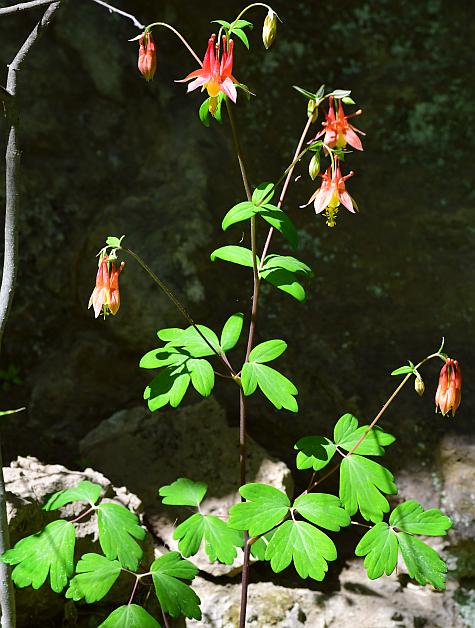Aquilegia canadensis L.
Columbine

Native
CC = 6
CW = 3
MOC = 70
© SRTurner
Aquilegia canadensis L.Columbine | |
 |
Native CC = 6 CW = 3 MOC = 70 |
© SRTurner |
|
Family - Ranunculaceae Habit - Perennial herb. Stems - Erect, spreading, or arching, to 90 cm, usually few-branched, glabrous or sparsely to moderately pubescent with fine spreading hairs.
Leaves - Basal and alternate, short- to long-petiolate. Petioles to 10 cm long. Leaf blades twice ternately compound, the leaflets 17-52 mm long, ternately 1 or 2 times lobed, glabrous or hairy, green above, lighter and glaucous below.
Inflorescence - Solitary flowers or open clusters or groups of up to 10 flowers at the branch tips. Flowers pendent from long arching peduncles.
Flowers - Flowers actinomorphic, perfect. Sepals 5, 8-18 mm long, 3-8 mm wide, spreading, plane, ovate to broadly ovate, red, not persistent at fruiting. Petals 5, consisting of a flat to somewhat concave blade narrowed abruptly into a basal spur; the blade 5-9 mm long, oblong to oblong-circular, yellow; the spur 13-25 mm long, straight to slightly hooked inward or somewhat spreading, relatively stout toward the base, abruptly narrowed near the midpoint, and with a somewhat club-shaped tip, red. Stamens about 20, outer around the outer circumference shorter than the inner, the anthers yellow, the innermost usually replaced by a ring of papery staminodes. Pistils 5-10, each with many ovules. Styles to 1.3 cm, glabrous. Ovaries 4, 5mm long, tomentose, pale yellow-green.
Fruit - Follicles, to 3 cm, cylindrical, the wall thick and prominently veined, the beaklike tip curved outward at maturity, the beak 10-18 mm long. Receptacle not much enlarged at fruiting, the fruits in a ring.
Flowering - April - July. Habitat - Rocky ledges, rocky slopes, low woods. Also cultivated. Origin - Native to the U.S. Lookalikes - None. Other info. - The morphologically unusual flowers of this species make it impossible to mistake for anything else. The plant is common across most areas of Missouri, and across the upper Midwest and New England. It favors rocky areas, particularly crevices and small ledges on exposed rock faces. The spurs of the petals contain nectaries and are very attractive to insects equipped with long proboscises. This and other species of Aquilegia are attractive and easy to grow, making them popular garden ornamentals. Photographs taken in the Hercules Glade Wilderness, Mark Twain National Forest, Taney County, MO., 4-28-00 (DETenaglia); also at Shaw Nature Reserve, Franklin County, MO, 5-27-2011 and 5-1-2022; Glassberg Conservation Area, Jefferson County, MO, 5-9-2013; Washington State Park, Washington County, MO, 5-3-2014; and Mingo NWR, Stoddard County, MO, 5-23-2022 (SRTurner). |